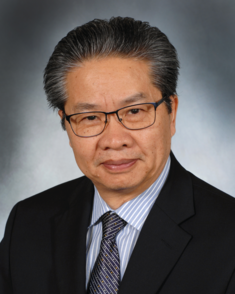Prof. Dr. G. R. Liu (University of Cincinnatti):
Lecture: Computational Methods: indispensable tools for engineering analysis and design
This talk provides an overview of computational methods and its applications to the analysis and design of engineering systems. The focus will be on general formulations of mesh-free and element-based methods established using strong, week and weakened weak (W2) formulations. Studies on the comparisons of W2 formulations with the strong and weak formulations will be presented. We will present a family of W2 models known as S-PIM and S-FEM developed in the recent years. Properties of this class of methods important for automations in computation will be discussed including, spatial and temporal stability and convergence, softening effects induced by various types of smoothing domains, upper bound properties leading to certified solutions real-time computational models, and insensitivity to the quality of mesh allowing effective uses of triangular/tetrahedral meshes, which are best suited for adaptive analyses. For CFD problems, the gradient smoothing methods (GSM) will be briefly introduced. Application examples will also be presented for simulating engineered material behavior at various extreme situations, fluid structural interaction problems (helicopter blades interacting with subsonic airflows, flying birds, etc.), cracks in engineering aerospace structural systems, crystal plasticity for metallic polycrystalline used in jet engines, integrity assessment of systems via inverse analysis with real-time computation., and additive manufacturing processes.
Keywords: FEM, meshfree, S-FEM, S-PIM, GSM, CFD, FSI, numerical methds, modeling and simulation, weakened weak formulation
Biography
Dr. Liu received PhD from Tohoku University, Japan in 1991. He was a PDF at Northwestern University, USA from 1991-1993. He is currently a Professor and Ohio Eminent Scholar (State Endowed Chair) at the University of Cincinnati. He authored a large number of journal papers and books including two bestsellers: “Mesh Free Method: moving beyond the finite element method” and “Smoothed Particle Hydrodynamics: a Meshfree Particle Methods.” He is the Editor-in-Chief of the International Journal of Computational Methods, Associate Editor of IPSE and MANO. He is the recipient of numerous awards, including the Singapore Defence Technology Prize, NUS Outstanding University Researcher Award and Best Teacher Award, APACM Computational Mechanics Awards, JSME Computational Mechanics Awards, ASME Ted Belytschko Applied Mechanics Award, and Zienkiewicz Medal from APACM. He is listed as a world top 1% most influential scientist (Highly Cited Researchers) by Thomson Reuters in 2014-2016, 2018. ISI citations by others:~14000. ISI H-index:~68; Google Scholar H-Index: 94.
References
[1] Liu GR, Quek SS. The Finite Element Method: A Practical Course. 2nd Edition, BH: Oxford, 2013.
[2] Liu GR, Nguyen Thoi Trung. Smoothed Finite Element Methods. CRC Press, NewYork, 2010.
[3] Liu GR. Mesh-free methods: moving beyond the finite element method. CRC Press, Boca Raton, 2nd Ed., 2009.
[4] Liu GR and Liu MB, Smoothed Particle Hydrodynamics: A Meshfree Particle Method, World Scientific, 2003.
[5] Liu GR and Zhang GY, Smoothed Point Interpolation Methods -- G Space Theory and Weakened Weak Forms, World Scientific, 2013
[6] Liu GR. On G space theory. IJCM 2009; 6(2), 257-289.
[7] Liu GR. A G space theory and a weakened weak (W2) form for a unified formulation of compatible and incompatible methods: Part I theory & Part II applications. Int J Numer Meth Eng 2010; 81(9): 1093-1156.
[8] Liu, G. R., Jiang, Y., Chen, L., Zhang, G. Y., & Zhang, Y. W. (2011). A singular cell-based smoothed radial point interpolation method for fracture problems. Computers & Structures, 89(13-14), 1378-1396.
[9] Liu, G. R., & Zhang, G. Y. (2009). A novel scheme of strain-constructed point interpolation method for static and dynamic mechanics problems. International Journal of Applied Mechanics, 1(1), 233-258.
[10] Liu, G. R., Zhang, G. Y., Wang, Y. Y., Zhong, Z. H., Li, G. Y., & Han, X. (2007). A nodal integration technique for meshfree radial point interpolation method (NI-RPIM). Int J Solids Struct, 44(11-12), 3840-3860.
[11] Chen JS, Wu CT, Yoon S, You Y. A stabilized conforming nodal integration for Galerkin mesh-free methods. INT J NUMER METH ENG 2001; 50:435–466.
[12] Liu GR, Zhang GY, Dai KY, Wang YY, Zhong ZH, Li GY, Han X. A linearly conforming point interpolation method (LC-PIM) for 2D solid mechanics problems. IJCM 2006; 2:645–665.
[13] Zhang GY, Liu GR, Wang YY, Huang HT, el al. A linearly conforming point interpolation method (LC-PIM) for three-dimensional elasticity problems. Int J Numer Meth Eng, 2007; 72:1524 – 1543.
[14] Liu GR, Li Y, Dai KY, Luan MT, Xue W. A linearly conforming radial point interpolation method for solid mechanics problems. IJCM 2006; 3:401–428.
[15] Liu GR, Zhang GY. Edge-based smoothed point interpolation method (ES-PIM). IJCM 2008; 5(4): 621-646.
[16] Liu GR. A generalized Gradient smoothing technique and the smoothed bilinear form for Galerkin formulation of a wide class of computational methods. IJCM 2008; 5(2): 199-236.
[17] Liu GR, Dai KY, Nguyen-Thoi T. A smoothed finite element method for mechanics problems. COMPUT MECH 2007; 39: 859-877.
[18] Liu GR, Nguyen-Thoi T, Dai KY, Lam KY. Theoretical aspects of the smoothed finite element method (SFEM). INT J NUMER METH ENG 2007; 71: 902-930.

